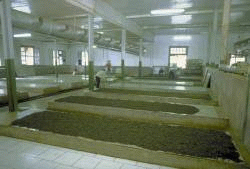Food-Info.net> Products > Tea
Tea production
The production of tea involves several steps :
- Withering
- Rolling
- Oxidation (‘fermentation')
- Drying
- Packing
Although the process is relatively simple, each step has to be controlled carefully to obtain the proper flavours and taste.
Withering
The objective of withering is to reduce the moisture in the tealeaf by up to 70% (varies from region to region).
Tea is laid out on a wire mesh in troughs. Air is then passed through the tea removing the moisture in a uniform way.
This process takes around 12 to 17 hours. At the end of this time the leaf is limp and pliable and so will roll well.

Withering. (Source)
Rolling
Tea is placed into a rolling machine, which rotates horizontally on the rolling table. This action creates the twisted wiry looking tealeaves. During the rolling process the leaves are also broken open, which starts the third process.
Instead of the more traditional and gentle rolling, two other methods are used for the production of mainly black tea for the finer end of the scale, i.e. fanning and dust grades. These teas are usually destined for teabag production.
The CTC production method :
CTC stands for crushing, tearing and curling. The withered leaf is often cut to a uniform size by machine. Then the leaves are fed into the CTC machine where they are crushed, torn and curled in a single operation by metal rollers. The extracted cell sap is collected and added to the leaves again. The crushed leaves are then oxidised, dried and sorted. The CTC method is mainly used in Indian regions.
The LTP method :
The third method of producing black tea is the LTP method, named after the inventor of the relevant machine, the Lawrie Tea Processor. In this method, the withered leaves are often levelled before being processed in the LTP machine. Here they are virtually torn to pieces by blades rotating at high speed. This is followed by the usual oxidation, drying and sorting procedures.
Oxidation (fermentation)
Once rolling is complete, the tea is either put into troughs or laid out on tables whereby the enzymes inside the tealeaf come in to contact with the air and start to oxidise. This creates the flavour, colour and strength of the tea.
It is during this process that the tealeaf changes from green, through light brown, to a deep brown, and happens at about 26 degrees centigrade
This stage is critical to the final flavour of the tea, if left too long the flavour will be spoilt.
Oxidation takes from between half an hour to 2 hours.
This process is monitored constantly with the use of a thermometer along with years of experience. The tea then passes to the final stage of drying.
The longer oxidised, the darker the tea. Green teas are not oxidised or for a very short period of time. Oolong teas (see here) are partially oxidised, whereas black teas are more fully oxidised.
Often this step is referred to as fermentation. However, fermentation requires the use of micro-organisms (bacteria, moulds, yeasts, such as in bread, beer), which is not the case for the tea fermentation. Tea fermentation is a chemical oxidation process.
Drying
To stop the oxidation process the tea is passed through hot air dryers. This reduces the total moisture content down to about 3% and stops the enzymes. The oxidation will be stopped by this process, and now the dried tea is ready to be sorted into grades before packing. For grades, see file grading.
Packing
Tea is normally packed in large wooden boxes and exported. It can further be packed in smaller
packages, tea bags etc.




